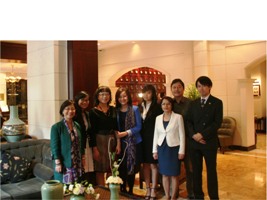Latest News
Activities
Japanese Partner
On 17 June 2016, the Ministry of Finance issued Circular No.
83/2016/TT-BTC guiding the implementation of investment incentives prescribed
in the Law on Investment No.67/2014/QH13 and Decree No. 118/2015/ND-CP (“Circular
83”).
Circular 83 clarifies the incentives in terms of corporate income taxes (“CIT”), import duty (“ID”), and non-agricultural land use tax (“NALUT”), with detailed guidance on applications, especially for investment projects in the fields of science and technology and agriculture. Bellows are several key points of Circular 83.
Corporate income tax incentives:
The science and technology enterprises, which satisfy statutory science and technology revenues level as required by the laws on science and technology, are entitled to CIT incentives as enterprises conducting investment in high-tech zones (Article 4.6.b).
Expanded projects as
defined in the Article 14.4 of the Law on Corporate income taxes are entitled to CIT incentives
during the remaining operational period, if any, or CIT exemptions or
reductions on the increased revenue created by the expansion. The period
of taxes exemption or reduction on revenues from
expanded projects is equal to the taxes exemption or reduction period for new
projects in the same area or sector qualifying for CIT incentives (Article 4.8).
If an investment project is entitled to different types of CIT incentives, its investor can choose the most favorable
incentives to apply (Article
4.5).
Import duty incentives based on investment
sectors or investment areas:
Projects in special incentive investment
sectors or implemented in special disadvantaged socioeconomic areas, are entitled to both ID exemptions on
imported goods that constitute fixed assets and ID exemptions regarding
importation of materials, supplies and components which cannot be produced
domestically in five years commencing from the starting date of production (Article 5.1).
Projects in hotel, office or apartment buildings for lease,
residential houses, commercial centers, engineering services, supermarkets,
golf courses, tourist sites, sports facilities, entertainment places,
healthcare service facilities, training and cultural centers, finance, banking,
insurance, auditing and consultancy services are only exempted from paying ID
for imported goods constituting fixed assets for the first time (Article 5.3).
The ID incentives are not applicable to projects in mining;
production, trading of commodities and provision of services that subject to
special consumption tax, except for automobile production (Article 5.7).
Non-agricultural land use tax incentives based
on investment sectors or investment area:
Projects in special incentive investment sectors or implemented in special disadvantaged socioeconomic areas are entitled to exemption from NALUT (Article 6.1).
The NALUT are not applicable to projects in mining; production,
trading of commodities and provision of services subject to special consumption
tax, except for automobile production (Article 6.7).
Import duty and non-agricultural land use tax
incentives based on capital scale or human resources:
Projects with total capital of at least VND6 trillion (roundly
equivalent to USD273 million) that is disbursed within three years from the
issuance date of investment registration certificate or investment policy
decision are entitled to ID and NALUT as projects implemented in special
incentive investment sectors or implemented in special disadvantaged
socioeconomic areas, on the basis of the investor’s declaration. Projects which
fail to disburse at least VND6 trillion in the above period are not entitled to
such incentives (Article 5.4 and 6.3).
Projects in rural areas and having at least 500 employees who are
neither part-time employees nor employees with under-12-month labor contract
nor employees working at non-rural areas, are entitled to incentives as
projects in the incentive investment sectors or implemented in special
disadvantaged socioeconomic areas (Article 5.5 and 6.4).
Circular 83 will take effect on 1 August 2016. Regarding projects
having Investment Licenses, Investment Certificates, or other equivalent
documents before 1 July 2015 and domestic projects with capital scale of less
than VND15 billion implemented before 1 July 2015, tax policy incentives shall
be regulated by the provisions which came into effect prior to 1 July 2015
(Article 7).





.jpg)

